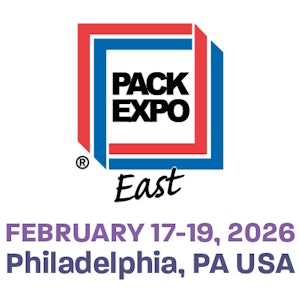Flexible packaging is pliable, that is to say, it flexes. Source reduction espouses using less at the beginning so that there’s less to dispose of later. Since flexible packaging contains less material than does rigid packaging, its association with source reduction is not surprising; nonetheless, that association is neither as straightforward nor as simple as it’s often presented.
The use of flexible packaging yields a package-to-product weight ratio that translates into fewer trucks and less emissions; however, flexible packaging was being promoted on that basis even before sustainability grabbed headlines. Since then, the flexible packaging industries have emphasized additional sustainability qualities, not all of which are as unimpeachable as those related to transportation.
One example is the claim that the production of flexible packaging consumes less energy than does the production of rigid packaging. It’s not a given. That’s because flexible packaging includes paper, foil, and film, not only as individual substrates, but also in combined structures, such as laminations and coextrusions. Regarding the last two, energy is consumed in the production of the individual substrates and later in the converting processes.
Advocates of flexible packaging boast about its sustainability credentials, but caution: to be long on verve and short on veracity risks backlash from stakeholders, including regulators. It’s an unnecessary risk because flexible packaging can hold its own in the sustainability debate, without resorting to hyperbole. The reason is that so much of the calculus used for quantifying sustainability is subjective, thereby allowing any particular category of packaging to stake out its own territory within the sustainability landscape. That’s not necessarily a bad thing. It allows the various categories to continue the contributions on which their existences have been built, while providing an incentive to improve themselves vis-à-vis sustainability.
The petroleum-based plastics segment of flexible packaging is criticized by some for not being from a renewable resource. There’s no denying that fact. There’s also no denying that all of the aforementioned comments about source reduction also apply to plastics. As for the renewable resource argument, the various bio-polymers have enjoyed modest success, at best, and nothing presages that they will grow beyond niche applications.
Survey results that rank sustainability as a top influencer of consumers’ purchase behavior are not verified by marketplace results, ditto for results claiming a willingness to pay premium prices for the sake of sustainability. Consumers are reluctant to sacrifice. That characteristic is known by CPG companies, given that so many of their offerings promise some form of convenience (for example, time-saving, labor-saving, etc.).
Regarding flexible packaging, source reduction can be a competitive advantage. But the easier quantifiable benefits might not reside with the consumer but rather with supply chain activities and operations upstream from the consumer. Examples include storage and handling efficiencies stemming from lighter, less dense materials.
Specific to the consumer, a company’s strategy should be three-fold: make one’s best, good-faith effort at sustainability; avoid overselling the results; and, expect consumers to consider sustainability/source reduction as a tie-breaker, when all other relevant factors (i.e. price, quality, and value) are equal.
For years on end, flexible packaging has enjoyed impressive growth and forecasts continue to be optimistic. However, if that growth has not been driven primarily by source reduction/sustainability, then by what? The answer is multifaceted, but to generalize, flexible packaging has utilized technologies to build brands and provide a competitive advantage, through protection, communication, and convenience.
The protection provided by flexible packaging is owed less to its physical strength and more to its barrier properties. The more demanding requirements are met by multilayer structures. By necessity, source reduction plays a role. Typically, the barrier layer is the most expensive; therefore, the challenge is to incorporate it as thinly as requirements allow. The challenge applies to the entire structure, actually, because the objective is the thinnest, most cost-effective structure feasible. Additional advantages accrue elsewhere; for example, for a given overall diameter of a roll of material, the thinner the material, the more of it that can be wrapped around the core. That—among other results—means fewer changes of rolls on the packaging line.
The communication prowess of flexible packaging has benefited from printing technologies, principally flexography and rotogravure. High-impact graphics are able to project whatever aura the brand-owner desires. An additional ability to communicate is possessed by flexible packaging that is see-through, allowing product visibility. And by its very nature, flexible packaging communicates source reduction. Most, if not all, consumers are aware of the concept of overpackaging; therefore, they intuitively grasp the concept that flexible packaging is less packaging, even without being overtly told.
The convenience of flexible packaging addresses multiple consumer preferences. A breakthrough in easy opening, closing, and resealing came with the two-part, interlocking strip, now common on a variety of bags and pouches. Efficient use of storage space is another convenience. A similar convenience, when the contents are not dispensed all at once, is flexible packaging’s ability to fold down, reducing its size as the contents are consumed. With large or heavy products, ease-of-handling is a decided convenience, conceivably in the form of die-cut slots for gripping. And, as product weight and size increase, the more source reduction becomes an appreciated characteristic of flexible packaging.
Where is the next standup pouch? What innovations will spearhead future growth? And which end-user industry will lead the way? Of flexible packaging, source reduction comes with the territory, one favorable to smart, imaginative exploration. A compass will serve better than a map. That’s because those explorers need to head in the right direction, but as for a specific path, remain flexible.
____________________________________________________________________________________________
Sterling Anthony is a consultant, specializing in the strategic use of marketing, logistics, and packaging. His contact information is: 100 Renaissance Center- P.O. Box 43176; Detroit, MI 48243; 313-531-1875 office; 313-531-1972 fax; [email protected]; www.pkgconsultant.com


























